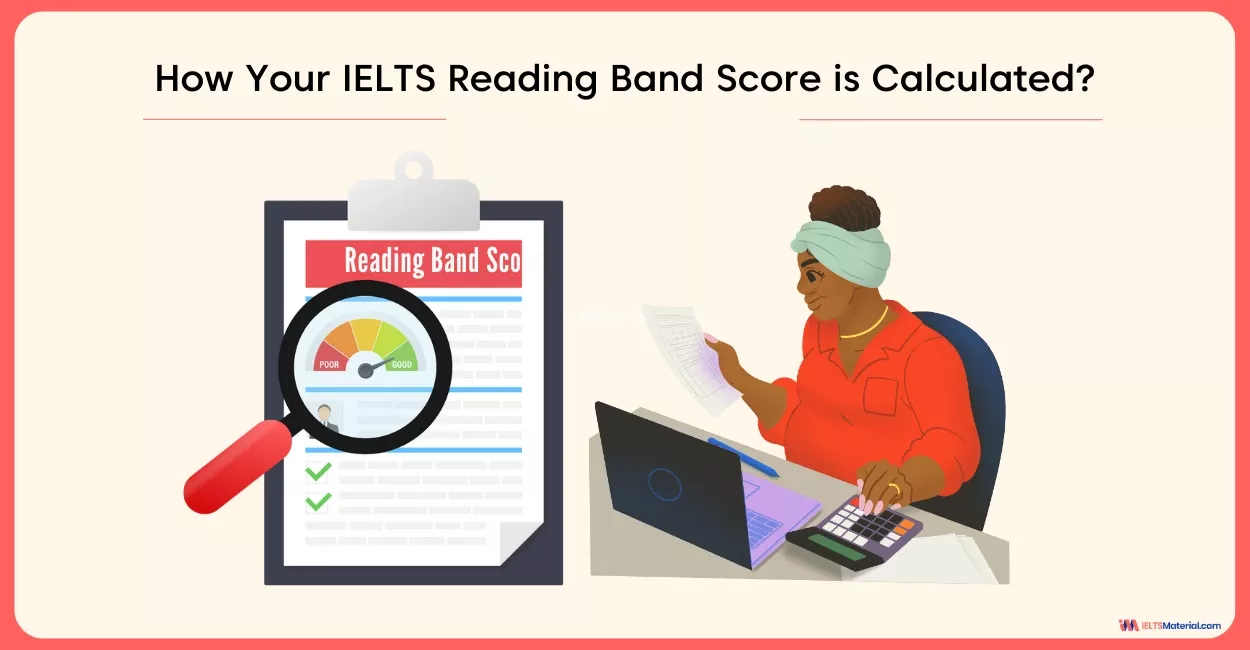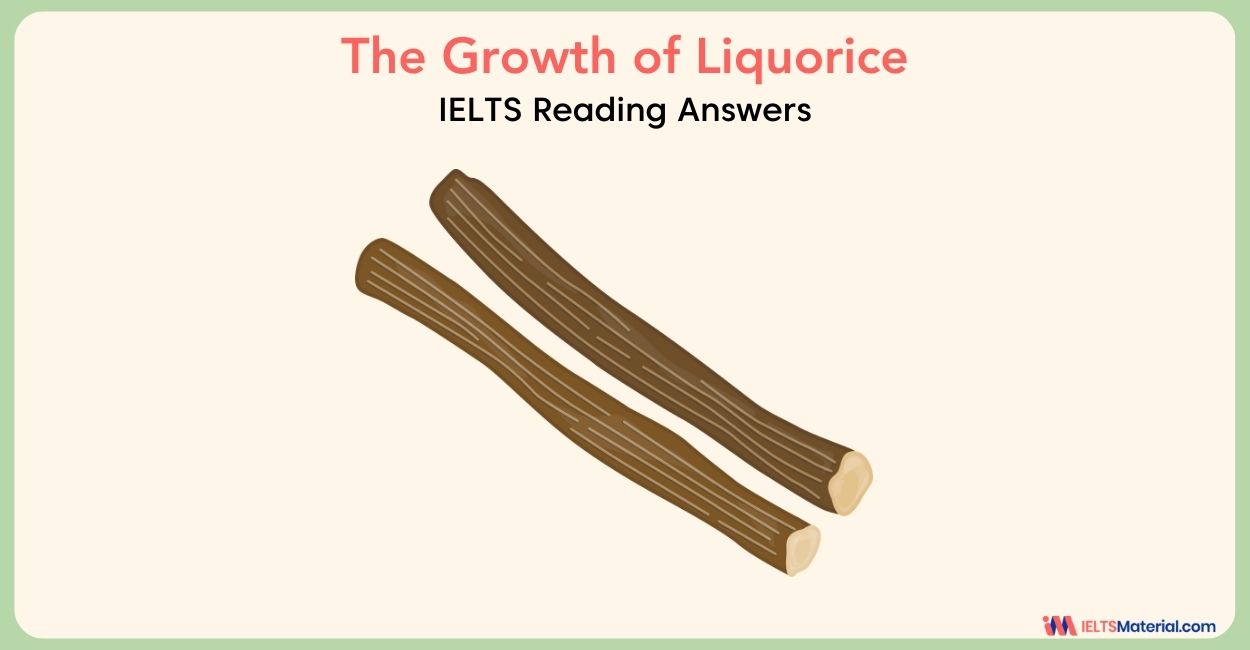The Growth of Liquorice - IELTS Reading Answers
13 min read
Updated On
-
Copy link
Level up your preparation with the passage on The Growth of Liquorice and use the specific strategies to answer different question types to practice while aiming to achieve a band 8+ in the IELTS exam.
Table of Contents

Limited-Time Offer : Access a FREE 10-Day IELTS Study Plan!
The Growth of Liquorice consists of 13 questions where you would encounter different question types. With diligent practice, you will be able to understand how to approach and answer the different question types in the IELTS Reading Module. You will be assessed based on your ability to locate information, identify the main ideas, and understand the arguments made in the passages. However, you would have time constraints where you will only have 60 minutes to complete answering 40 questions.
By solving and reviewing Sample Reading questions from past IELTS papers, you can ensure that your Reading skills are up to the mark. You can attempt the passage on The Growth of Liquorice and then check the answers which are provided at the end. This would help you to level up your preparation while pinpointing the areas of improvement. With regular practice sessions, you will be able to understand a few useful tricks which will guide you in finding the right answer and achieve a band 8+.
Let's get started!
Connect with our band 9 IELTS Trainers to crack your IELTS Reading in no time! Book a FREE Demo.
Types of Questions in The Growth of Liquorice - IELTS Reading Answers
As you prepare for the IELTS Academic Reading, you need to first look at the questions before checking the passages. This is because you can prepare yourself to attempt any type of questions which you might encounter in the exam. You will be able to answer them confidently and with ease since the Academic passages are longer comparatively. Therefore, looking at the question types would save time and also help you to skim and scan through the passages and locate information. Below are the different question types for the passage on The Growth of Liquorice:
- IELTS Reading Multiple Choice Questions (Q. 1-5)
- IELTS Reading True False Not Given (Q. 6-10)
- IELTS Reading Matching Endings (Q. 11-13)
Want to learn tricks to answer Matching Sentence Endings? Before you start, dive into the strategies by looking at the video below.
Tricks to Attempt The Growth of Liquorice for Achieving a Band 8+
By applying specific tricks to attempt the question types given in the passage, 'The Growth of Liquorice', you would be able to achieve a higher band score of 8+. Remember that each question would require specific strategies to be implemented. As you prepare, continue utilizing these tricks so that you can improve your reading pace while understanding the information provided in the passage. Let's dive right into the tips to prepare yourself.
- Take a look at the passage but do not read it word by word which might be time-consuming. By glancing at the passage, you will get a grasp of the content and structure of the information. This will also help you in pinpointing the keywords provided in the question.
- Reading the instructions is crucial and ensure that you follow them.
- You must manage time effectively by getting familiar with the Time Management for IELTS Reading. This will help you to note the time you are taking to attempt different question types. By putting the timer on, you will be able to get a clear picture about the questions where you need more practice.
- Most IELTS reading questions follow the order which is given in the passage. You can therefore use this pattern to find each answer and come back to the difficult questions later on.
- Spend around a minute for one question which will give you some time to go through the entire passage. However, try not to rush too much so that you assume the answers based on only the keywords.
- Most of the questions are paraphrased where there might be synonyms or different words given in the question. Therefore, you need to practice using the IELTS Vocabulary words.
- Skimming and scanning the information are two important techniques which will help locate the answers in the passage. But remember to read the sentence or the surrounding words so that you can comprehend the context easily.
- Learn How to Ace IELTS Reading with 'Keyword Technique' so that you can look at the question and then spot where the information is in the passage. With this technique, you will improve your reading speed.
Reading Passage - The Growth of Liquorice
The Growth of Liquorice
A LIQUORICE has a long, honourable history in the service of mankind. Alexander The Great, the Scythian armies and the Roman Emperor Caesar,are all on record for endorsing the beneficial properties contained in liquorice. Warriors used it as a substitute for water on a march, while others recognized liquorice’s valuable healing properties.
B Native to Asia and the Mediterranean region, liquorice (Glycyrrhiza glabra) in the family Leguminosae is a tall shrub (1.5 m) with blue or violet flowers. The most common variety, Spanish liquorice, is characterized by blue flowers, while Russian liquorice has violet blossoms. The name glycyrrhiza comes from Greek words meaning ‘sweet root’. The roots contain the medicinally active constituents, and the plant requires rich soils and grows in subtropical climates. It is indigenous to Turkey, Iraq, Spain, Greece and northern China.
C The plants are graceful and their leaves have an almost feathery appearance from a distance. The leaves hang down during the night on each side of the stem, though they do not meet beneath it. From the leaves, spring spikes of small pale-blue, violet or purplish flowers, followed by small pods somewhat resembling a partly grown pea pod in form.
D The underground system, as in so many Leguminosae, is double: one part consisting of a vertical or tap root, often with several branches; the other of a horizontal runner, coming off the root below the surface of the ground. These runners have leaf buds and throw up stems in their second year. The perennial downward-running roots, as well as the long horizontal runners, are equally preserved for use.
E English·grown liquorice is dug up in late autumn and sold mostly in its fresh state for making extract, with only a small amount being dried. When washed, fresh English liquorice is a bright yellowish brown. It is very flexible, with a light yellow, juicy internal substance, which consists of a thick bark surrounding a woody column. The root has a peculiar earthy odour and a strong, characteristic, sweet taste. The English extract of liquorice, made from the fresh home-grown root, is said to have a more delicate flavour than that of imported varieties.
F In southern Italy, large quantities of liquorice root are grown, but it is chiefly converted into extract, though some of the root is exported. Spain and the south of France provide quantities of carefully dried liquorice root. Up to the year 1890, the cultivation of Spanish liquorice was small or moderate in comparison with the wild collection. Owing, however, to the depletion of the natural supplies of good quality root, this cultivation has grown rapidly in southern and southern-central Europe, where the climate is favourable.
G Nearly all the Russian liquorice that has been exported has already been peeled. It reaches a much larger size than the Spanish variety, and the taste, although sweet, is accompanied by a subtle bitterness or acridity. It consists chiefly of roots, not runners, in long and often crooked pieces, about 5 cm in thickness. These are pale yellow externally,and are a lighter yellow and softer internally than the Spanish variety.
H Spain was formerly the main supplier, which explains why the extract is still referred to as ‘Spanish Juice’, but the best grade has almost disappeared. The sticks vary in size, but are commonly about 2 cm in diameter and 15 or 18 cm in length. When imported, they are usually wrapped in bay leaves.
I Liquorice grows best on sandy soil near streams and is usually not found in the wild more than 50 metres from water. It will not flourish on clay and prefers the rich, fine soil of lowlands in river valleys, where there is an abundance of moisture during the growing period. Liquorice also flourishes where the ground hardens during the hot, dry summer months.
J The plant grows most successfully in a warm climate. Not only can it not endure severe freezing, but cool weather interferes with the formation of the sweet liquorice juice and makes the plant woody. It appears that climates which are particularly favourable for the production of oranges are also favourable for liquorice.
K Owing to the depth to which the root penetrates and its propagation, the plant is a persistent weed in cultivated grounds, where it is indigenous and exceedingly difficult to remove by its roots. It is very healthy and robust and rarely subject to disease. It can successfully occupy the ground to the exclusion of other planes. For this reason, the continuation of a natural supply may be considered as assured, although it is liable to suffer from severe depletion due to being overpicked.
Questions 1-5
Choose FIVE letters, A-F.
Which FIVE of the following statements about the liquorice plant are true according to the passage?
A The health properties of liquorice are not well known.
B Liquorice used to be valued as a means to quench thirst.
C Liquorice plants only grow in tropical climates.
D Liquorice blossoms are blue or violet.
E Liquorice flowers last for a long time.
F The leaves of the liquorice plant look like feathers.
G Pods develop on the plant after the flowering stage.
H Medicine is derived from the flowers of the liquorice plant.
I The liquorice root system has two roots.
J Horizontal runners develop stems immediately.
1 ……………………….
2 ……………………….
3 ……………………….
4 ……………………….
5 ……………………….
Questions 6-10
Do the following statements agree with the information given in the Reading Passage?
Write
TRUE if the statement agrees with the information
FALSE if the statement contradicts the information
NOT GIVEN if the information is little information on this
6 Only some of the English liquorice is harvested in the autumn.
7 Improved varieties of liquorice have a stronger taste than English liquorice.
8 After 1890, the production of Spanish liquorice declined slowly.
9 Russian liquorice is not popular because it has a bitter taste.
10 Russian and Spanish varieties of liquorice have identical flavours.
Questions 11-13
11 Wild liquorice is usually found near streams because it
12 To guarantee the development of juice, the liquorice plant
13 In some areas, the liquorice plant is a problem because it
A requires a warm climate.
B flourishes on clay.
C needs a lot of water.
D tolerates very low temperatures.
E spreads very easily.
Want to improve your IELTS Academic Reading score? Check out the IELTS Reading (Academic) Test Guide: Essential Tips, Strategies, and Practice Tests” (April-June 2025)
Answer with Location and Explanation for The Growth of Liquorice
Did you attempt the passage on 'The Growth of Liquorice'? Was there any question type which might seem intimidating to you? Let's check the answers and note the location as well as the explanation so that you can learn how to find the correct answer. This will help you to achieve a higher IELTS Reading Band Score of 8+. The table below shows the answers to the passage which will guide you with your reading preparation.
| Answer | Question Type | Answer Location | Answer Explanation |
| 1. B | Multiple Choice Question | Paragraph A, line 3 | In the given location, it is given that “Warriors used it as a substitute for water on a march…”. This referred line shows that warriors have used liquorice as a means to quench thirst ( as a substitute of water). Hence, the answer is B. |
| 2. D | Multiple Choice Question | Paragraph B, line 1 | In the mentioned line, it is given “Native to Asia and the Mediterranean region, liquorice (Glycyrrhiza glabra) in the family Leguminosae is a tall shrub (1.5 m) with blue or violet flowers.”. This reference proves that liquorice blossoms (flowers) are blue or violet. Hence, the answer is D. |
| 3. F | Multiple Choice Question | Paragraph C, line 1 | In the specified line, it is given “The plants are graceful and their leaves have an almost feathery appearance from a distance.”. In other words, the leaves of the liquorice plant look like feathers (have an almost feathery appearance). Hence, the answer is F. |
| 4. I | Multiple Choice Question | Paragraph D, line 1 | In the fourth paragraph, it is stated that “The underground system, as in so many Leguminosae, is double: one part consisting of a vertical or tap root, often with several branches; the other of a horizontal runner, coming off the root below the surface of the ground.”. It can be pointed out that the liquorice root system has two roots – one is a vertical or tap root and the other is a horizontal runner. Hence, the answer is I. |
| 5. J | Multiple Choice Question | Paragraph D, line 1 – line 2 | Through reference lines like, “…the other of a horizontal runner, coming off the root below the surface of the ground. These runners have leaf buds and throw up stems in their second year.”, it can be concluded that the second root of the liquorice plant (horizontal runners) has leaf buds and develops stems immediately (in the second year). Hence, the answer is J. |
| 6. False | True/False/Not Given | Paragraph E, line 1 | In the mentioned section, it is stated that “English·grown liquorice is dug up in late autumn and sold mostly in its fresh state for making extract, with only a small amount being dried.” Based on this reference, we can conclude that the statement (only some of the English liquorice is harvested in the autumn.) contradicts the information since all types of English liquorice are harvested in autumn. Hence, the answer is False. |
| 7. True | True/False/Not Given | Paragraph E, line 5 | In Paragraph E, it is said that “The English extract of liquorice, made from the fresh home-grown root, is said to have a more delicate flavour than that of imported varieties.”. This points out that the improved varieties of liquorice have a stronger taste than English liquorice which has a more delicate flavour. As the statement agrees with the information, the answer is True. |
| 8. False | True/False/Not Given | Paragraph F, line 3 – line 4 | The following lines –Up to the year 1890, the cultivation of Spanish liquorice was small or moderate in comparison with the wild collection. Owing, however, to the depletion of the natural supplies of good quality root, this cultivation has grown rapidly in southern and southern-central Europe, where the climate is favourable. – establishes the fact that after 1890 the production of Spanish liquorice increased, especially in areas where the climate is favourable. Hence, the answer is False. |
| 9. Not Given | True/False/Not Given | NA | Although it is mentioned that Russian liquorice has a bitter aftertaste, there is no information if it is the reason this variety is unpopular. Hence, the answer is Not Given. |
| 10. Not Given | True/False/Not Given | NA | Athough there are comparisons in the size of the Russian and Spanish liquorice, there is no information on Russian and Spanish varieties of liquorice having identical flavours. Hence, the answer is Not Given. |
| 11. C | Matching Sentence Endings | Paragraph I, line 1 – line 2 | The given line specifies that “Liquorice grows best on sandy soil near streams and is usually not found in the wild more than 50 metres from water. It will not flourish on clay and prefers the rich, fine soil of lowlands in river valleys, where there is an abundance of moisture during the growing period.”. It is indicated that liquorice grows near streams as it needs an abundance of moisture in the growing period. Hence, the answer is C (needs a lot of water.). |
| 12. A | Matching Sentence Endings | Paragraph J, line 2 | In the paragraph, it is given “The plant grows most successfully in a warm climate. Not only can it not endure severe freezing, but cool weather interferes with the formation of the sweet liquorice juice and makes the plant woody.”. This reference proves that to guarantee the development of juice, the plant requires a warm climate as low temperature dries it up and makes it woody. Hence, the answer is A (requires a warm climate.). |
| 13. E | Matching Sentence Endings | Paragraph K, line 1 | The given line specifies that “Owing to the depth to which the root penetrates and its propagation, the plant is a persistent weed in cultivated grounds, where it is indigenous and exceedingly difficult to remove by its roots.”. It is indicated that in some areas the liquorice plant is considered as a weed as it spreads very quickly (propagation) and is very difficult to uproot. Hence, the answer is E (spreads very easily). |
Enroll into our Free IELTS Webinar and learn more about techniques to improve your reading speed.
Remember to focus on each question type and the specific tricks so that you can attempt any question that comes your way. By practising with passages like 'The Growth of Liquorice', you will not only learn how to approach the questions but also get an idea about your progress level. It is important to keep a track so that you can prepare and strengthen your weak areas. With consistent practice, you will build confidence which is needed for the exam day and achieve a band 8+.
Check More Reading Passages
Also Check :
Practice IELTS Reading based on question types

Start Preparing for IELTS: Get Your 10-Day Study Plan Today!
Explore other Reading Practice Tests

Kasturika Samanta

Nehasri Ravishenbagam

Nehasri Ravishenbagam

Kasturika Samanta
Recent Articles

Nehasri Ravishenbagam

Haniya Yashfeen

Haniya Yashfeen

Haniya Yashfeen




Post your Comments